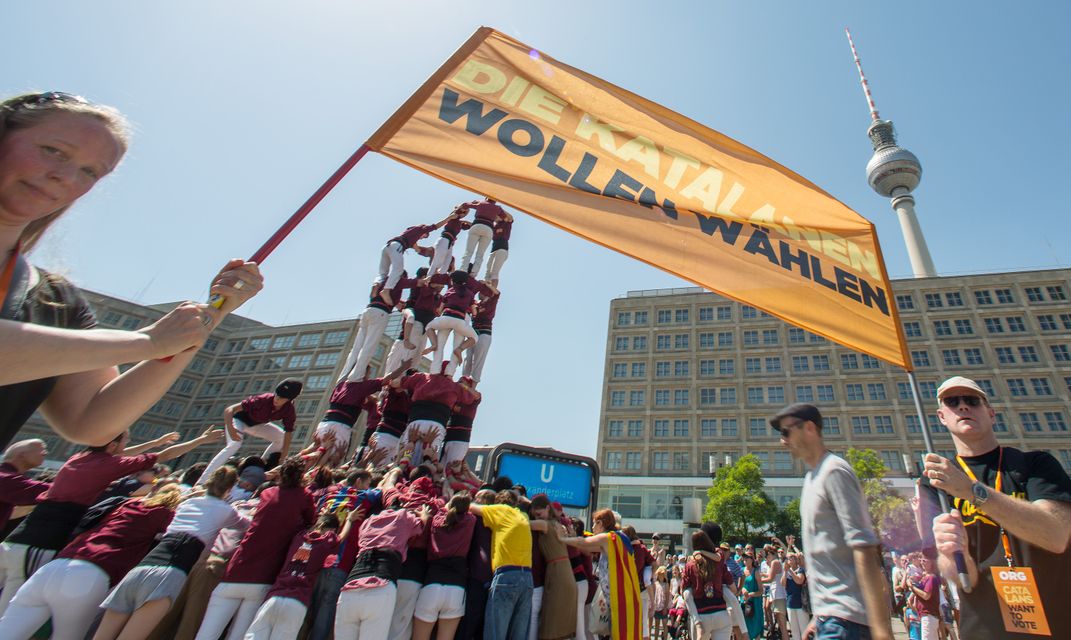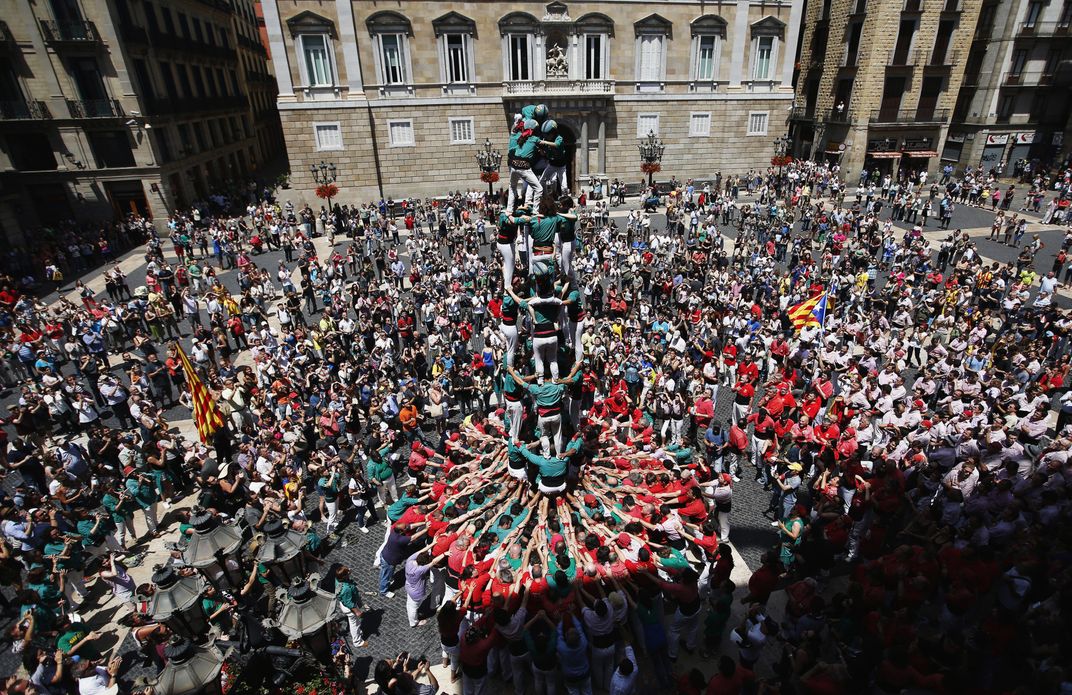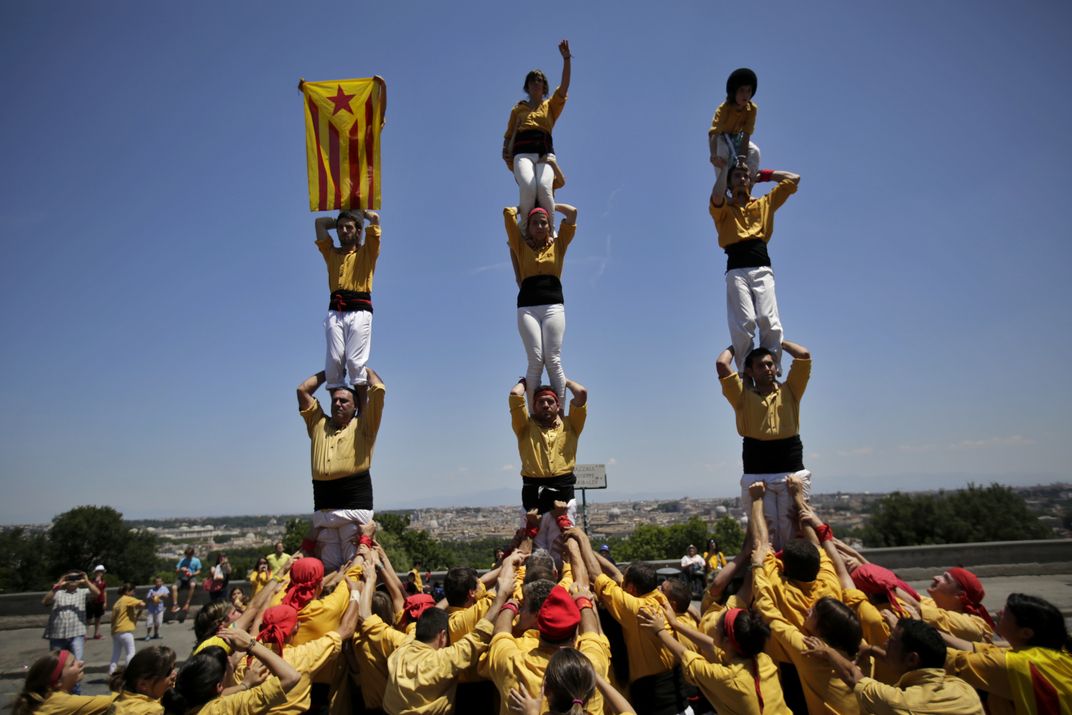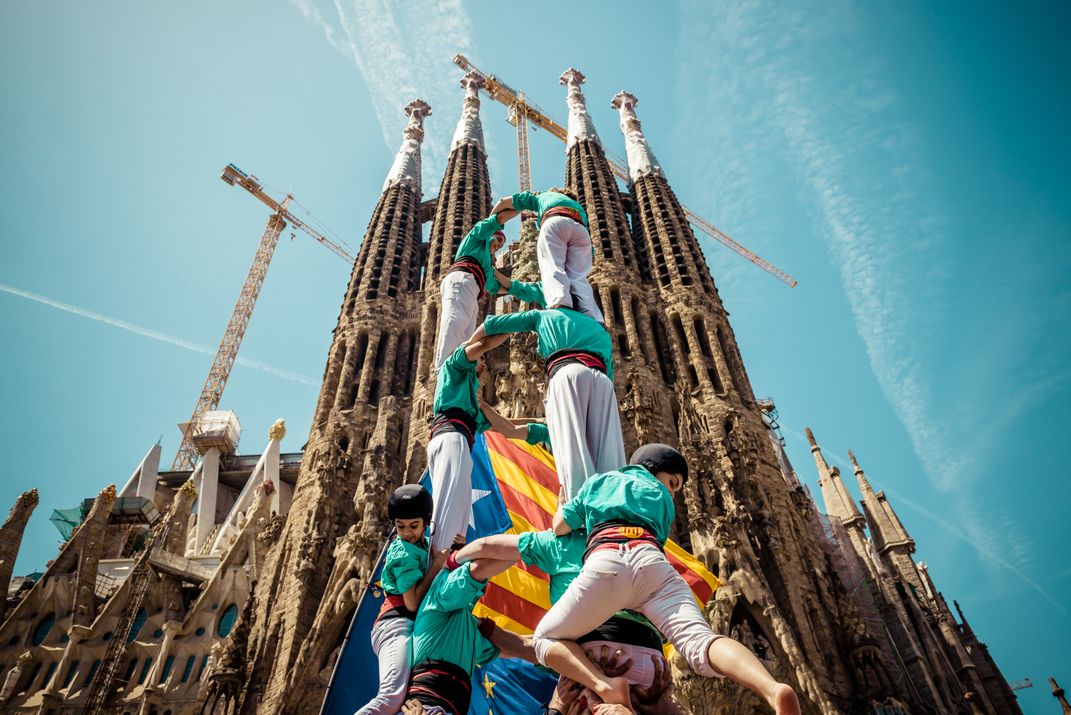What Does a 36-Foot-Tall Human Tower Have to Do With Catalan Independence?
An eye-catching protest across Europe is steeped in cultural heritage says Smithsonian curator Michael Atwood Mason
In the past few days, in the central squares of eight European capitals, Catalans from northeastern Spain launched an innovative, if quirky, publicity stunt. At noon on June 8, Barcelona-time—the region’s major city, they raised traditional human towers in a coordinated campaign dubbed: “Catalans want to vote. Human Towers for Democracy.” The movement also sparked a following and human towers rose up in more than 60 other towns and cities, including Montreal and Santiago in Chile.
The Catalans are actively seeking international support for a referendum on November 9th, allowing a vote to settle the question of an independent state for the region. The Spanish government maintains that the Catalans have no legal right to pose this question, but most Catalans think that as members of European democracy, they can call for a non-binding plebiscite. The use of human towers to draw attention to the fact that they want their voices to be heard is a dramatic and intriguing display of a performance that was declared in 2010 by UNESCO as an “Intangible Cultural Heritage of Humanity.”
The Catalan struggle for independence has its roots in culture as much as it does in economics and politics. Catalans speak a unique Romance language, distinct from the French and Spanish spoken in the region, and Catalonia’s political identity dates to the 12th century. Catalonia became part of unified Spain, when King Phillip V abolished its local laws in the first decades of the 18th century.
For centuries, the region maintained its separate identity while under Spanish rule, but by the 1930s, the Spanish dictator Francisco Franco, who held a particular contempt for Catalonia, enforced a series of measures to stamp out its distinctive language and culture. The Catalan language was not taught in schools or generally used in public, and Catalan versions of names were not permitted on birth certificates or other public records.
Since the beginning of the 20th century, a vibrant independence movement led by a number of strong civic organizations promotes and advocates for this distinctly Catalan culture. Barcelona’s Palace of Catalan Music in Barcelona, often considered a modernist masterpiece, was designed and built by Gaudí’s teacher, Lluís Domènech i Montaner, for the Orfeó Català, a choral music group that sought to provide a broad public access to Catalan music. The current government in Madrid permits the use of the Catalan language, but teaching Catalan in schools continues to be hotly debated. Catalans often also point out that the central government levies more taxes in Catalonia than it reinvests in government services. In 1961, while Spain was still under Franco’s rule, five Catalan men formed Òmnium Cultural to promote Catalan culture and language. Their organization collaborated with the Coordinating Committee of Human Tower Teams of Catalonia to mount the recent performances in Berlin, Brussels, Geneva, Lisbon, London and Paris.
The human towers or castells, date to the 18th century, when people in the local town of Valls began to build these remarkable temporary structures at annual festivals. Since that time, local clubs have passed on the tradition, and the amateur teams compete each year at large festivals under the motto “strength, balance, courage, and seny”—a particularly Catalan value that mixes good sense and a calm demeanor and is often contrasted with rauxa, a sense of careless abandon.
The team members that mount the castells wear a simple uniform that includes white pants, a colored shirt, a bandana and a faixa, a sash up to 36-feet-long that provides back support and a handle for climbers. Ideally the castell rises and falls with a smooth and elegant ease. The towers are traditionally called by the number of stages and people per stage—it can have between one and five people per stage. So a castell with three people per stage and five stages is called a "3 by 5." The most ambitious human towers may contain ten stages, but only two human towers in the last 200 years have been assembled and disassembled with that claim to fame.
At the base is the bulky pinya, the band of people who support the weight of the tower. Then climbers descend up the backs of the members of the base and onto their shoulders, locking arms, and stabilizing that stage. The next set of climbers repeat the action until the last stage is completed, but it is amazing to watch as there can be three or four people crawling up the outside of the human tower at once. Really tall castells include a central tower inside the outer ring to provide support, and that pillar stays in place until the rest of the tower is dismantled.
The last person up is usually a child wearing a safety helmet (the Coordinating Committee recently employed modern standards for safety), who stands at the top of the tower, sometimes on the shoulders of nine other people. This child traditionally holds up four fingers, a gesture that evokes the four red strips on the Catalan flag and turns this interesting human feat into an act of cultural nationalism. When Catalans reflect on tower building, they often stress the sense of “community, cooperation and integration—a metaphor or ideal of what many Catalans aspire for Catalonia to be one day,” as Catalan historian Meritxell Martin-Pardo explains.
The Catalans’ use of traditional culture to make a political statement is not unique, but what is remarkable here is how that they are using cultural performances as a tool to build support for their desire for self-determination. This strategic use of cultural and artistic expression is part of what some scholars are calling cultural democracy, the idea that people have the right to determine how their cultural life develops. Cultural democracy also embraces the idea that people use their cultural art forms as a tool to seek their own best interests and their cultural values to chart their course through the present and into the future. It reflects the basic human right to free expression as enshrined in Article 19 of the Universal Declaration of Human Rights. It honors and celebrates cultural diversity, and it nurtures active participation in the cultural life of communities. Like others engaged in cultural democracy around the world, the Catalans are using traditional culture to make a modern point about a very real and relevant issue of the day: They are building human towers for democracy.
/https://tf-cmsv2-smithsonianmag-media.s3.amazonaws.com/accounts/headshot/Mason_Michael-12012.jpg)

/https://tf-cmsv2-smithsonianmag-media.s3.amazonaws.com/filer/78/3e/783ea98e-1e19-4f99-b7af-1adc40958629/42-59275539.jpg)

/https://tf-cmsv2-smithsonianmag-media.s3.amazonaws.com/filer/c3/84/c384472c-3416-4d08-9cb1-a7f77dee5ac7/42-59279815.jpg)
/https://tf-cmsv2-smithsonianmag-media.s3.amazonaws.com/filer/34/39/3439989a-d637-4b66-8993-2054d5aa9661/42-59288310.jpg)
/https://tf-cmsv2-smithsonianmag-media.s3.amazonaws.com/filer/eb/0b/eb0b44fd-094b-4e89-b2b9-e1da87d17c58/42-59288394.jpg)
/https://tf-cmsv2-smithsonianmag-media.s3.amazonaws.com/filer/f4/07/f407f8cd-b2a5-4b87-b147-7185b15d29d0/42-59288341.jpg)


/https://tf-cmsv2-smithsonianmag-media.s3.amazonaws.com/filer/03/3b/033ba29f-ead3-4b98-b4ec-020e4bf8c938/42-59293167.jpg)
/https://tf-cmsv2-smithsonianmag-media.s3.amazonaws.com/filer/56/69/56692781-fb0f-4d24-8c98-340de9bba667/42-59288414.jpg)



/https://tf-cmsv2-smithsonianmag-media.s3.amazonaws.com/accounts/headshot/Mason_Michael-12012.jpg)